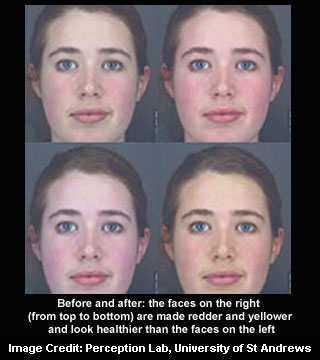
For the purpose of better understanding this criterion, researchers examined a total of 54 Caucasian participants of both sexes. Further, the participants were asked to manipulate the skin color of male and female Caucasian faces to make them look as healthy as possible, via specialist computer software. They seem to have chosen to increase the rosiness, yellowness and brightness of the skin.
“Most previous work on faces has focused on the shape of the face or the texture of the skin, but one of the most variable characteristics of the face is skin color. We knew from our previous work that people who have more blood and more oxygen color in their skin looked healthy, and so we decided to see what other colors affect health perceptions. This has given us some clues as to what other skin pigments may relate to a healthy appearance,†says Dr Ian Stephen who was previously at St Andrews but is now in the Department of Experimental Psychology at the University.
Skin that is somewhat flushed with blood and full of oxygen apparently suggests a strong heart and lungs, supporting the study’s findings that rosier skin seemed healthy. Moreover, smokers and people with diabetes or heart disease may perhaps have fewer blood vessels in their skin, and so their skin would appear less rosy.
The preference for more golden or ‘yellow-toned’ skin as healthier could possibly be elucidated by the ‘carotenoid pigments.’ Supposedly, these carotenoid pigments are obtained from the fruit and vegetables in our diet.
Besides, these plant pigments are known to be powerful antioxidants that soak up dangerous compounds produced when the body combats disease. Additionally, they are important for our immune and reproductive systems and may assist in preventing cancer. Moreover, they are the same dietary pigments that brightly colored birds and fish utilize in order to show off their healthiness and attract mates. The researchers believe that similar biological mechanisms may be at work in humans.
“In the West we often think that sun tanning is the best way to improve the color of your skin. But our research suggests that living a healthy lifestyle with a good diet might actually be better,†says Stephen.
“What we eat and not just how much we eat appears to be important for a healthy appearance. The only natural way in which we can make our skin lighter and more yellow is to eat a more healthy diet high in fruit and vegetables,†says Professor David Perrett, head of the Perception Lab at the University of St Andrews, where the research took place.
Melanin is known to be the pigment that causes the tan color when the skin is exposed to the sun thereby making the skin darker and more yellow. However, participants in the study appear to have chosen to make skin lighter and more yellow to make it look healthier. This discovery seems to be very exciting and has given the researchers a promising lead into cues to health.
The findings of the research will be published in the journal, International Journal of Primatology.
